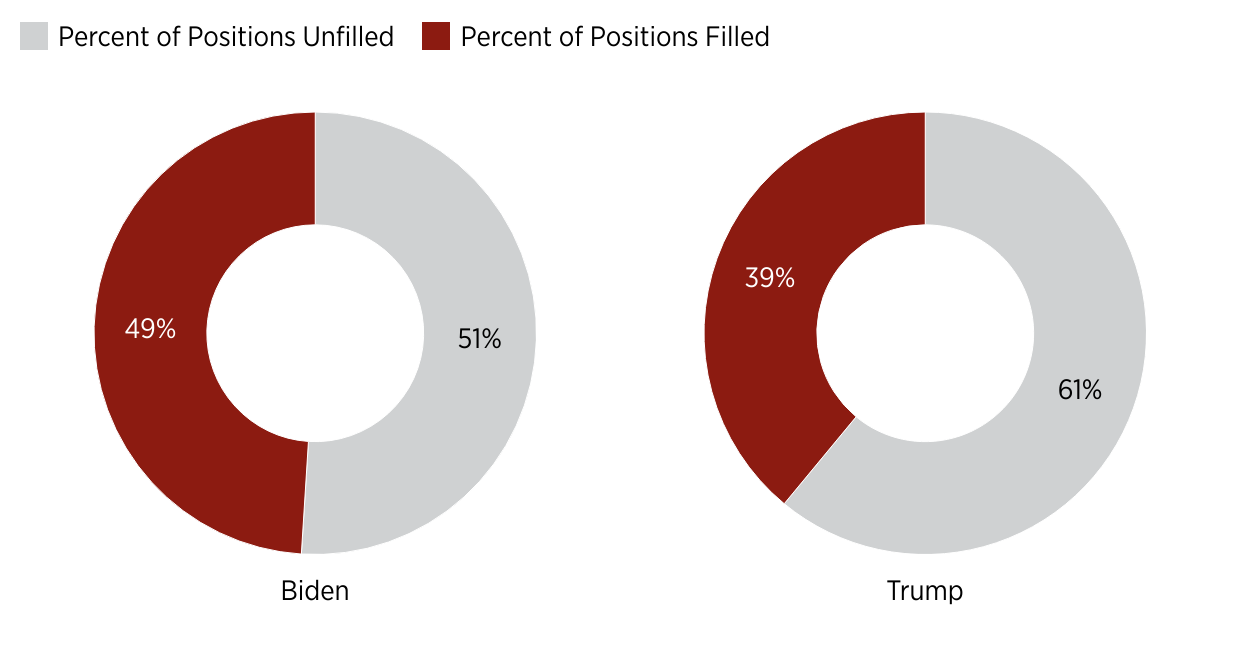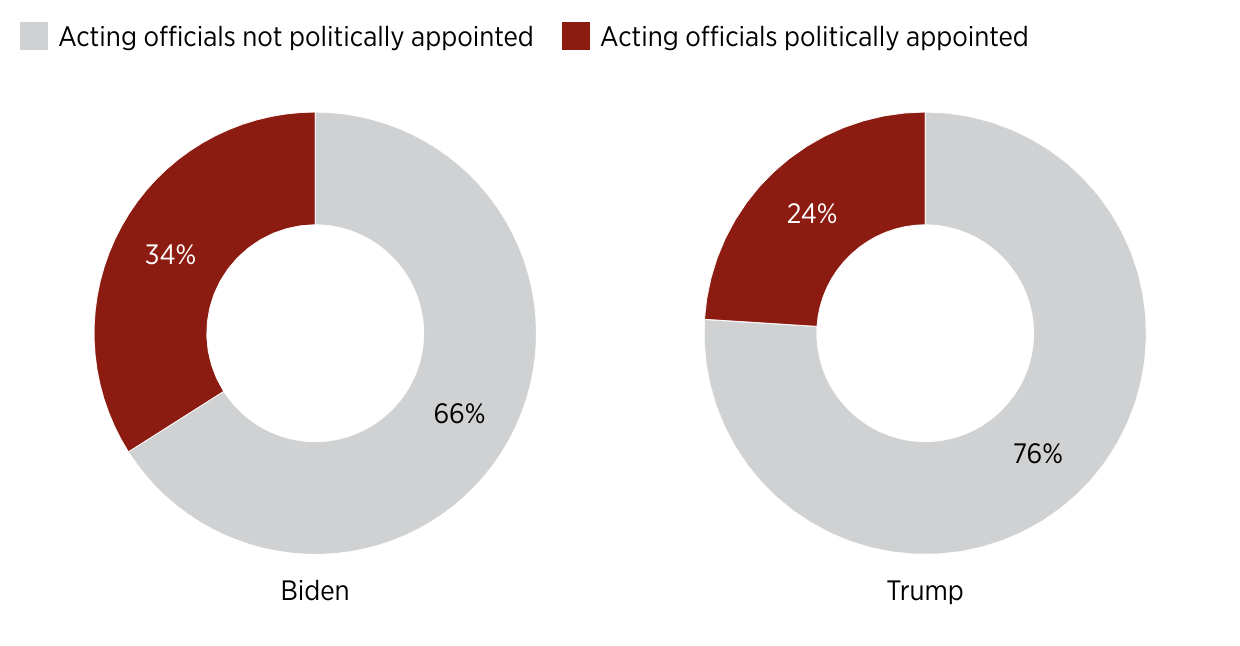
Presidents can use different strategies for filling positions with acting officials depending on when the vacancy occurs.
Beginning of an administration
At the beginning of their term, presidents can choose to rely on the following categories of officials to serve in an acting capacity:
- The first assistant to the position. At the start of an administration, this person will likely be a career employee. But in some situations, an administration can bring in a political appointee as a first assistant and then designate that person as the acting official.
- Holdover Senate-confirmed officials from the previous administration.
- High-level officials who have been with the agency at least 90 days during the year preceding the vacancy—again, likely to be career officials.
As this list suggests, presidents, particularly at the beginning of their administrations, may rely on capable career officials to serve on an interim basis. Many of these high-level career officials have served in leadership roles across administrations.
One of many such examples is David Huizenga, a career civil servant in the Department of Energy selected by Biden as acting secretary of Energy at the beginning of his administration. Trump previously selected Huizenga as acting deputy administrator for defense nuclear nonproliferation in the National Nuclear Security Administration and, before that, he had served for more than 20 years in the DOE, with stints in several high-level positions. For his work at the NNSA, Huizenga was a finalist for the Samuel J. Heyman Service to America Medal by the Partnership for Public Service.
Presidents may also appoint individuals to non-Senate-confirmed principal deputy or first assistant positions on day one of their administration and simultaneously place those officials in an acting role by default. This strategy skirts the requirement that officials serve in the agency for at least 90 days in the year preceding the vacancy to qualify for acting service.
Biden relied heavily on this strategy at the beginning of his term. For example, he appointed Stephanie Pollack to be the deputy administrator of the Federal Highway Administration. Pollack, who had served as the Massachusetts secretary of Transportation for the previous six years, simultaneously became the acting administrator of the FHWA. This maneuver enabled Biden to place a qualified appointee in charge of the FHWA early in his presidency. He did not have a Senate-confirmed administrator in this position until the end of his second year in office.
We recommend that incoming transition teams do the following:
  |
Review agency succession plans for each noncareer position provided by the incumbent administration, statutorily required by Sept. 15 of an election year. These plans help transition teams identify senior career officials to either serve in acting capacities by default or be selected to serve on an interim basis while the new administration gets its people in place. |
 |
Identify the existing non-Senate-confirmed positions that are first assistants to Senate-confirmed roles that could be filled immediately (e.g., positions not filled by career Senior Executive Service members, who are protected at the beginning of an administration from reassignment). |
 |
Create a separate vetting group within the personnel team of the transition to prioritize hiring those non-Senate-confirmed appointees. |
The Biden-Harris Transition Team used this strategy, creating two different personnel groups—one for non-confirmed appointments and one for Senate-confirmed positions—to appoint a record 1,100 appointees on Inauguration Day. Some of these appointees were placed in senior roles as first assistants. Having non-confirmed first assistants in place was a highly effective strategy that enabled political appointees to step into senior acting roles from day one of the Biden administration.
Middle of an administration
Presidents in the middle of their terms have a greater range of options to fill vacancies.
To begin with, presidents in this situation have a greater pool of their own Senate-confirmed and non-Senate-confirmed appointees who are eligible to serve as acting officials. Senate-confirmed officials are often relied on to serve as acting officials when the most senior Senate-confirmed positions become vacant. For example, Trump had Patrick Shanahan, confirmed as deputy secretary of Defense, and Mark Esper, confirmed as secretary of the Army, serve in two separate stints as the acting secretary of Defense after the resignation of James Mattis.
Presidents can also select senior career officials or senior non-Senate-confirmed appointees who have been with the agency for at least 90 days in the year preceding the vacancy to serve as acting officials. For example, Trump selected Norman Sharpless to serve as the acting commissioner of the Food and Drug Administration after the permanent commissioner, Scott Gottlieb, resigned. Sharpless had served in the Department of Health and Human Services for over a year as the director of the National Cancer Institute, a non-Senate-confirmed appointed role.
In some cases, presidents may also consider selecting an acting official to also serve as their nominee to a vacant position. Generally, the Supreme Court has said that the Vacancies Act does not allow the nominee to concurrently serve as the acting official. However, the act allows individuals to serve in an acting role and also be nominated for the position if they had been the first assistant to the position for at least 90 days during the year preceding the vacancy or if they are a Senate-confirmed first assistant to the position.
Biden took advantage of this rule when he nominated Shalanda Young as director of the Office of Management and Budget while she served as the agency’s acting director. Since Young was the “first assistant” to the director and met both the service length and Senate-confirmation requirements, she continued as the acting director while she was nominated.
Presidents can also change agency succession orders or the determination of “first assistants” to alter who becomes an acting official by default—unless the order of succession is laid out in statute.
When there is not a statutory provision for succession planning for a Senate-confirmed position, agencies generally specify one via regulation. However, presidents can alter them through executive or secretarial order.
Along these lines, presidents may also create new appointed noncareer SES or Schedule C positions and designate them as the “first assistant” to a Senate-confirmed position. This strategy enables presidents to select an official in the newly designated or created “first assistant” position in an acting capacity, regardless of whether the individual has been with the agency at least 90 days prior to the vacancy.
Presidents have been using this strategy given their preference to place political leaders in priority areas. But the Partnership for Public Service and other good government organizations recommend that presidents carefully consider whether a career official or political appointee is the best choice for the first assistant role. Not only are career civil servants likely to have relevant experience to serve capably, but the absence of a political appointee acting in the role encourages the administration to make a formal nomination to fill the position permanently.
The creation of a new first assistant position—especially if a nominee is not forthcoming—risks irritating Congress because it may give the appearance that the White House and the agency are intentionally skirting the Senate’s advice-and-consent role. The nomination process, while long and uncertain, is the only way to break the acting cycle and get permanent political leaders into leadership roles.
However, there may be limitations on the president or agency head’s ability to change succession orders or create new “first assistant positions” if the vacancy has already occurred.
For example, there were legal challenges to the status of the acting secretary of Homeland Security in 2020 because agency leadership made amendments to the succession order after the Senate-confirmed secretary resigned. The Government Accountability Office found that the Department of Homeland Security could not legally change the order of succession for the secretary position because the individual who assumed the role as acting secretary did not do so according to the existing succession order and, therefore, could not approve the changes.
We recommend that federal leaders managing personnel do the following:
  |
Identify whether Senate-confirmed positions have an existing succession order and designated first assistant position. For key positions without a designated first assistant position, create or designate a first assistant position prior to vacancies occurring. |
 |
Work with departing Senate-confirmed officials to identify existing appointed or career personnel who can step into an acting role. |
Outside of the time period allowed by the Vacancies Act
According to the Vacancies Act, when the time limits to select an acting official end, all the duties and functions of vacant positions specifically assigned by statue or regulation may only be performed by the head of the agency.
Many observers note, however, that once these time limits end, an acting official’s title may switch from “acting” to something along the lines of “performing the duties of.” This switch is possible because, in practice, there are very few statutorily limited duties and functions for most Senate-confirmed positions. Therefore, individuals “performing the duties” of a vacant position often have the same legal authority of an acting official without the acting title.
Due to the difficult and often delayed Senate confirmation process, it has become more common to see officials “performing the duties of” vacant positions. In effect, this means that vacant positions can stay vacant well beyond the time limits set by the Vacancies Act.
For example, Patrick J. Lechleitner, the deputy director of Immigration and Customs Enforcement, started performing the duties of the director position in June 2023. Lechleitner has continued to perform the duties of the vacant position indefinitely, despite Biden withdrawing his last nominee to the position in July 2022.
This strategy can appear to be a clear circumvention of the time limits imposed by the Vacancies Act—an issue untested in federal court. So while using these types of titles is potentially legal, they nevertheless raise friction with Congress and confuse the public.
Presidents can mitigate these difficulties if they put forth nominations for vacant positions. As described above, doing so would pause the time limit on an official serving in an acting capacity.
We recommend that administrations carefully consider whether a career official or political appointee would best “perform the duties of” vacant positions. We also recommend that presidential personnel teams do the following:
  |
Track the acting time limits allowed under the Vacancies Act. |
 |
Ensure that individuals previously serving as acting officials cease to use the “acting” title when the time limits run out. |
 |
Examine any nondelegable duties of vacant Senate-confirmed positions that must be performed by the head of the agency. |
Additional considerations for the selection of interim officials
The types of individuals called upon to be acting officials varies depending on the type of vacant position.
As noted above, the most senior leadership positions, such as Cabinet secretaries, are typically filled by political appointees when vacant (except at the beginning of an administration when an incoming president works to get senior political appointees in place). These individuals are perceived as having greater backing from the president—and by the Senate when they are a Senate-confirmed official.
However, positions such as assistant secretaries, directors, commissioners and administrators may be more easily filled by career officials serving in deputy roles. Using career officials helps the president fill positions with capable and experienced individuals and limit the search costs for the Presidential Personnel Office. For example, Biden has relied on Troy A. Miller to perform the duties of the commissioner for U.S. Customs and Border Protection for much of the current term. Miller previously served as the deputy commissioner, the agency’s senior career official. Before that, he served in a series of career leadership roles.
Additionally, it may be better for presidents to rely on career officials in vacant mission-support positions. It is particularly important to fill these positions with individuals with institutional knowledge and the necessary skills and expertise. Senior career officials offer stability while the president finds a capable nominee and waits for them to successfully navigate the Senate confirmation process.
For example, Denise Carter has served as the acting assistant secretary of Finance and Operations and the chief financial officer at the Department of Education under Biden. She has also been the Department of Education’s career principal deputy assistant secretary of finance and operations since 2013.








